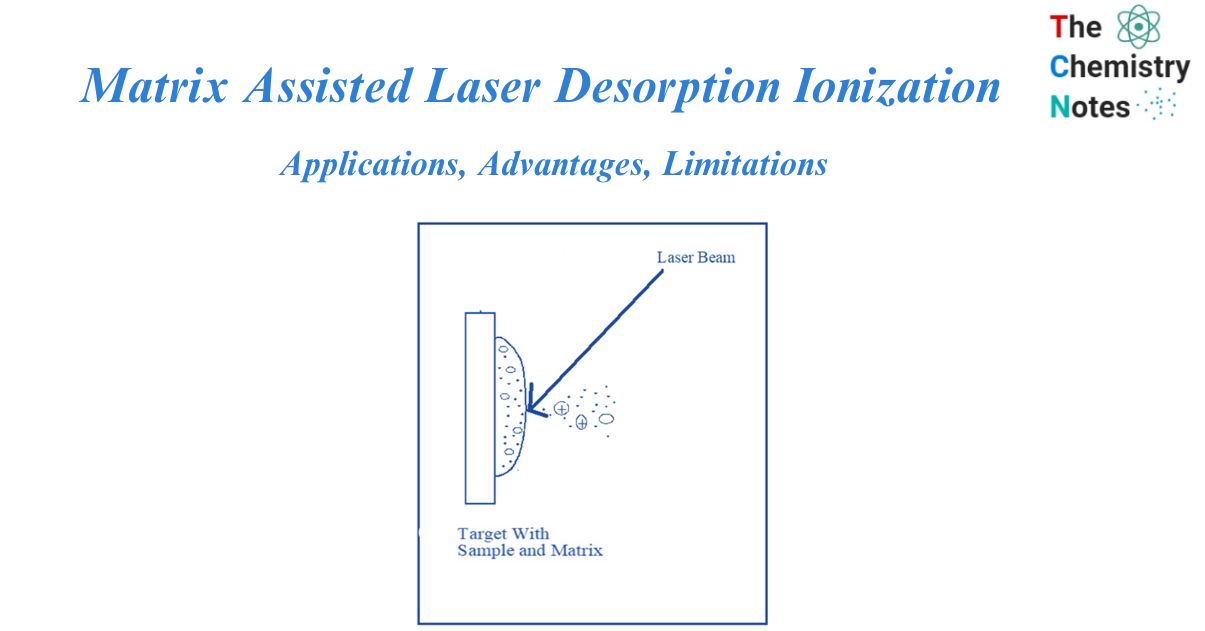
Matrix Assisted Laser Desorption Ionization (MALDI) is a soft ionization technique used in mass spectroscopy that allows the analysis of biomolecules (biopolymers such as DNA, proteins, peptides, and sugars) and organic molecules (such as polymers, dendrimers, and other macromolecules) that are fragile and fragment when ionized by more conventional ionization methods.
A laser is used to produce ions from high molecular-weight substances such as proteins and polymers.
Interesting Science Videos
What is matrix assisted laser desorption ionization?
Matrix assisted laser desorption ionization process involves the deposition of an analyte solution onto a metal substrate before the addition of a matrix. The matrix/analyte dry spot is exposed to a UV laser, and the laser energy that is absorbed by the matrix/analyte is converted into heat energy that initiates charge transfer, which results in the desorption of the matrix and analyte molecules in ionized form. The positive ions are then accelerated through a vacuum into MS analyses.
Ionization in Matrix assisted laser desorption ionization occurs via proton transfer, which is significantly less damaging to sensitive molecules. Furthermore, during the desorption process, the matrix absorbs laser energy and protects the analyte from being over-exposed and breaking down. Overall, this results in a technology that permits molecules to be analyzed without first destroying them, which is critical in several fields.
Mechanism of matrix-assisted laser desorption ionization
The Matrix-Assisted Laser Deposition/Ionization (MALDI) process is used to prepare an analyte for mass spectrometry. MALDI is a reasonably mild technology that can typically analyze molecules without considerable fragmentation.
The analyte is first mixed with a matrix, which is typically a crystalline substance dissolved in a solvent. The analyte/matrix solution is then spotted onto a metal plate, where the ionization process begins.
This is then exposed to pulsed laser light. In this case, the matrix protects the analyte and prevents harm from the strong laser. During this procedure, a proton is transported from a matrix molecule to the analyte. This effectively ionizes the analyte, eliminating the need for more intensive procedures that could harm the molecule.

Once the analyte has been ionized, it can be analyzed using a mass spectrometer. MALDI is frequently used together with a Time of Flight – Mass Spectrometer (ToF-MS), which separates the ions based on their distinct masses and charges as they travel the length of the machine. When the ions reach the spectrometer’s end, they are detected, and data on the masses and concentrations of the sample’s components can be obtained.
Choice of matrix
The matrix used for MALDI-IMS is determined by the analytes’ mass range and chemical characteristics. Sinapinic acid (3,5-dimethoxy-4-hydroxycinnamic acid ) is commonly used for high-weight molecules such as proteins, whereas α-cyano-4-hydroxycinnamic acid is commonly used for middle-weight compounds such as peptides. 9-aminoacridine (9-AA), is commonly employed for low molecular weight compounds like lipids or metabolites. While 9-AA usually works best for analysis in the negative-ion mode, DHB seems to work best in the positive-ion mode.
Matrix application method
Manual spraying with thin-layer chromatography (TLC) sprayers or airbrushes.
To achieve uniform application of the matrix, this approach should be carried out at a consistent room temperature and low humidity. Tissue sections can be coated with relatively tiny crystals quickly and cheaply using this technology.
Depositing small droplets of matrix solution automatically with robotic devices such as a chemical inkjet printer
When compared to manual spraying, the droplet spot size of this approach increases signal sensitivity but diminishes spatial resolution (>100-200 m). The inkjet printer’s restriction is a capillary blockage, which happens when extremely concentrated matrix solutions are utilized.
Matrix sublimation at low pressure and high temperature
Because this method does not require a solvent, diffusion of analyte molecules during matrix application is avoided. Another advantage is greater matrix purity and the production of very tiny matrix crystals.
Application of matrix assisted laser desorption ionization
- Matrix assisted laser desorption ionization is currently gaining popularity in pharmaceutical research due to its capacity to monitor drug metabolism, transport, and distribution.
- MALDI-MS is excellent for protein profiling of biological samples as well as protein identification from purified samples containing only a few distinct species.
- MALDI-TOF MS is a fast, accurate, and high-throughput technology for identifying microorganisms.
- Many laboratories use it routinely for gel-based proteomics.
- Other common MALDI-TOF-MS applications include top-down sequencing of intact proteins, microorganism profiling, genotyping, DNA mutation detection, investigation of posttranslational modifications, and DNA methylation.
- It is also used to examine synthetic polymers and, in some cases, small compounds such as medications and antibiotics.
- It is also necessary for bacterial identification and microbial fingerprinting.
Advantages of matrix assisted laser desorption ionization
- It is capable of producing large-mass ions with excellent sensitivity.
- When compared to other ionization procedures, it is a relatively soft ionization process that does not create a lot of fragmentation.
Limitation of matrix assisted laser desorption ionization
- In some circumstances, modest amounts of sample matter necessitate additional optimization procedures to produce high-quality findings.
- Furthermore, identifying large macromolecules can be challenging if current mass spectrum data is not available for comparison. As a result, it is always important to evaluate the type of sample to determine whether Matrix assisted laser desorption ionization is the best option.
References
- https://www.slideshare.net/anubhavsingh184007/matrix-assisted-laser-desorption-ioization-technique-by-anubhav-singh-mpharm
- https://measurlabs.com/methods/matrix-assisted-laser-desorption-ionization-maldi/
- https://chem.libretexts.org/Bookshelves/Analytical_Chemistry/An_Introduction_to_Mass_Spectrometry_(Van_Bramer)/03%3A_IONIZATION_TECHNIQUES/3.04%3A_Matrix_Assisted_Laser_Desorption_Ionization#:~:text=Matrix%20Assisted%20Laser%20Desorption%2FIonization%20(MALDI)%20is%20used%20to,polymers%2C%20proteins%2C%20and%20peptides.
- https://apps.dtic.mil/sti/pdfs/AD1067027.pdf
- https://www.medizin.uni-muenster.de/fileadmin/einrichtung/impb/MALDI/MALDI-Pictures/ijms_226_2003_189.pdf
